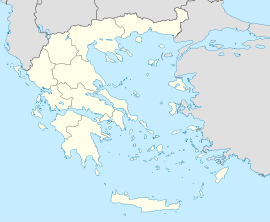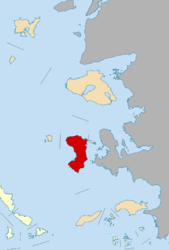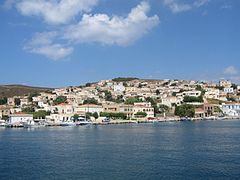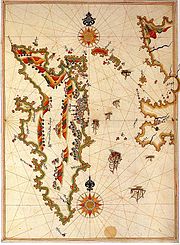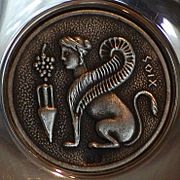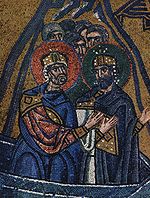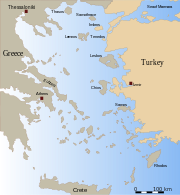- Chios
-
Chios
Χίος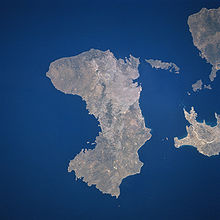
Satellite image of ChiosLocation Coordinates 38°24′N 26°1′E / 38.4°N 26.017°ECoordinates: 38°24′N 26°1′E / 38.4°N 26.017°E Government Country: Greece Region: North Aegean Regional unit: Chios Population statistics (as of 2001) Municipality - Population: 51,936 - Area: 842.5 km2 (325 sq mi) - Density: 62 /km2 (160 /sq mi) Other Time zone: EET/EEST (UTC+2/3) Elevation (min-max): 0 - 1,297 m (0 - 4255 ft) Postal: 82x xx Telephone: 227x0 Auto: ΧΙ Website www.chios.gr Chios (Greek: Χίος, pronounced [ˈçios]; alternative transliterations Khíos and Híos) is the fifth largest of the Greek islands, situated in the Aegean Sea, seven kilometres (five miles) off the Asia Minor coast. The island is separated from Turkey by the Chios Strait. The island is noted for its strong merchant shipping community, its unique mastic gum and its medieval villages. The 11th century monastery of “Nea Moni”, a UNESCO World Heritage Site, is located on the island.
Administratively the island forms a separate municipality within the Chios peripheral unit, which is part of the North Aegean Periphery. The principal town of the island and seat of the municipality is Chios (town).[1] Locals refer to Chios town as "Chora" ("Χώρα" literally means land or country, but usually refers to the capital or a settlement at the highest point of a Greek island).
Contents
Geography
Chios island is approximately crescent or kidney shaped, 50 kilometres (31 mi) long from north to south, 29 kilometres (18 mi) at its widest, and covers an area of 842 square kilometres (325 sq mi). The terrain is principally mountainous and arid, with a ridge of mountains running through the spine of the island. The largest of these, "Pelineon" (1,297 metres (4,255 ft)) and "Epos" (1,188 metres (3,898 ft)), are situated in the north of the island. The centre of the island is divided between east and west by a range of smaller peaks, known as "Provatas".
Regions
Chios can be classified into five regions:
East Coast
Midway up the east coast lies the main population centres, the main town of Chios and the regions of Vrontados and Kambos. Chios Town, with a population of 32,400, is built around the island's main harbour and medieval castle. The current castle, with a perimeter of 1400 m, was principally constructed during the time of Venetian and Ottoman rule; although remains have been found dating settlements there back to 2000 B.C. The town was substantially damaged by an earthquake in 1881 and only partially retains its original character.
North of Chios Town lies the large suburb of Vrontados (population 4,500), which lays claim as the birthplace of Homer. The suburb lies in the Omiroupoli municipality, and its connection to the poet is supported by an archaeological site known traditionally as "Teacher's Rock" (Δασκαλóπετρα).
Directly south of Chios Town lies the island's airport and the region of Kambos (Κάμπος, "plain"), a large fertile plain noted for its stone mansions and walled orchards. At the southern edge of the Kambos plain lies the town of Thymiana (Θυμιανά). Thymiana is noted as the sole source of a beige-burgundy two-tone sandstone used both in the local mansions and much of the town itself. Inland lie a number of villages rising up into the central mountains culminating with the village of Ayios Georgios Sykoussis perched at the peak dividing east from west. Along the coast lies Karfas (Καρφάς), a large sandy beach, which along with the nearby village of Ayia Ermioni (Άγια Ερμιόνη) is now the main tourist centre with a number of large and small hotels.
Southern Region
The south of the island is noted for the Mastichochoria (Μαστιχοχώρια, literally: Mastic Villages), the seven villages of Mesta (Μεστά), Pyrgi (Πυργί), Olυmpi (Ολύμποι), Kalamoti (Καλαμωτń), Vessa (Βέσσα), Lithi (Λιθί) and Elata (Ελάτα), which together have controlled the production of mastic gum in the area since the Roman period. The villages, built between the 14th and 16th centuries, have a carefully designed layout with fortified gates and narrow streets to protect against the frequent raids by marauding pirates. Between Chios Town and the Mastichochoria lie a large number of historic villages including Armolia (Αρμόλια), Myrmighi (Μυρμήγκι), and Kalimassia (Καλλιμασιά). Along the east coast are the fishing villages of Kataraktis (Καταρράκτης) and to the south Nenita (Νένητα).
The south coast is sparsely populated with only two populated areas; the modern bay of Komi and the ancient village of "Emporio", inhabited since 1800 BC, and the site of the black volcanic beach of "Mavra Volia" believed to have been created by the explosion of Santorini island in 1600 BC.

West Coast
The west coast, between the deep natural harbour of Limenas at the south and the town of Vrontados at the north, forms a crescent shaped series of almost uninhabited rocky bays. The nearest population centres being the two hillside villages of Lithi and Sidirounta, while further inland lie the villages of Elata, Vessa, Agio Giorgi, Avgonyma and the deserted village of Anavatos. On the west coast there still stands a system of stone beacons that were built at regular intervals to signal the approach of ships and warning the islanders against invasions by pirates.
Northern Region
The north of the island contains two major villages: Volissos on the west coast, and Kardamyla on the east. Further to the north, are three villages where cherries are grown—Amades, Viki and Kambia. In June Kambia holds an annual Cherry Festival—"Yiortí ton Kerrasión". Kambia holds several festivals during the summer months. Also located in the northern region is the island's tallest mountain, Mount Pelineon, at 1,297 metres (4,255 ft).
Spartounda and Fyta are a few miles before Kambia. In the village of Fyta stands a watchtower dating back to the late 16th century, the time of the Genoese occupation. Spartounda is the highest village of the island.
The village of Kourounia lies 20 kilometres (12 mi) north of Volissos in the northwestern part of the island. Next to Kourounia is the village of Egrigoros.
Interior
Directly in the centre of the island, between the villages of Avgonyma to the west and Karyes to the east, lies the 11th century monastery of Nea Moni, a UNESCO World Heritage Site. The monastery was lavishly built with funds gifted by the Byzantine Emperor Constantine IX, after three monks, living in caves nearby, had petitioned him while he was in exile on the island of Mytilene. The monastery had substantial estates attached, with a thriving community until the massacre of 1822. It was further damaged during the 1881 earthquake.[2] In 1952, due to the shortage of monks, Nea Moni was converted to a convent.
Further south is the region of Kambochoria. This is a collection of medieval villages (Halkios, Vavili, Vassileoniko, Ververato, Dafnonas, and Zifias) with a combined population of about 3,000 and an agricultural economy. In this region grows four varieties of wild tulips.
West of the Kambochoria on the central ridge of the island lies the 16th century village of Agios Geórgios Sikousis. The village is situated 400 metres (1,300 ft) above sea level, strategically overlooks both sides of the island, and was previously fortified with both wall and tower.
Geology
The Chios Basin is a hydrographic sub-unit of the Aegean Sea adjacent to the island of Chios.[3]
Climate
The island's climate is warm and moderate, categorised as Temperate, Mediterranean(Csa), with modest variation due to the stabilising effect of the surrounding sea. Average temperatures normally range from a summer high of 27 °C (81 °F) to a winter low of 11 °C (52 °F) in January, although, temperatures of over 40 °C (104 °F) or below freezing can sometimes be encountered.
Rainfall while usually plentiful, varies greatly both throughout the year and between years. Rain is rare during the summer months, but the winters are changeable and wet. Sunshine is plentiful, as is typical of the Eastern Mediterranean, with almost no cloud cover in the summer months. Average humidity varies from 75% in winter to 60% in summer.
The island normally experiences steady breezes (average 3–5 m/s) throughout the year, with winds direction predominantly northerly ("Etesian" Wind—locally called the "Meltemi") or south westerly (Sirocco).
Climate data for Chios, Greece Month Jan Feb Mar Apr May Jun Jul Aug Sep Oct Nov Dec Year Average high °C (°F) 11
(52)11
(52)13
(55)17
(63)22
(72)26
(79)28
(82)28
(82)25
(77)20
(68)16
(61)13
(55)19.2
(66.5)Average low °C (°F) 5
(41)5
(41)6
(43)9
(48)13
(55)17
(63)19
(66)19
(66)16
(61)12
(54)9
(48)6
(43)11.3
(52.4)Precipitation mm (inches) 100
(3.94)78
(3.07)61
(2.4)44
(1.73)24
(0.94)4
(0.16)1
(0.04)0
(0)8
(0.31)23
(0.91)55
(2.17)122
(4.8)520
(20.47)Source: www.weather-to-travel.com[4] History
Etymology
Known as "Ofioussa" (having snakes) and "Pityoussa" (having pine trees) in antiquity, during the medieval age the island was ruled by a number of external powers and has been also known as Scio (Genoese), Chio (Italian) and Sakız (صاقيز —Ottoman Turkish). The capital has also been called "Castro" or "Kastron" (Καστρον; meaning castle).
Pre-historic Period
Archaeological research on Chios has found evidence that the island has been inhabited since at least the Neolithic era. The primary sites of research for this period, have been cave dwellings at Hagio(n) Galas, in the north, and a settlement and accompanying necropolis in modern-day Emporeio at the far south of the island. The lack of information on this period however, cannot be overstated and theories on the size and duration of these settlements have not been well established.
The British School of Athens excavated the Emporeio site in 1952–1955, and most of our current information comes from these digs.[5] The Greek Archaeological Service (G.A.S.) has been excavating periodically on Chios since 1970, though much of their work on the island remains unpublished.
The noticeable uniformity in the size of houses at Emporeio is what primarily drives scholar's theory that there may have been no serious social distinction during the Neolithic on the island, the inhabitants instead all benefiting from agricultural and livestock farming.[6]
It is also widely held by scholars that the island was not occupied by humans during the Middle Bronze Age (2300–1600), though researchers have suggested recently that the lack of evidence that exists during this period may only demonstrate the lack of excavations on Chios and the northern Aegean.[7]
By at least the 11th century BC the island was ruled by a kingdom/chiefdom, and the subsequent transition to aristocratic (or possibly tyrannic) rule occurred sometime over the next four centuries. Future excavations may reveal more information about this period.[8] 9th-century Euboean and Cypriote presence on the island is attested by ceramics, while a Phoenician presence is noted at Erythrae, the traditional competitor of Chios on the mainland.[9]
Archaic & Classical Periods
Pherecydes, native to the Aegean, wrote that the island was occupied by the Leleges,[10] aboriginal Greeks themselves reported to be subject to the Minoans on Crete.[11] They were eventually driven out by invading Ionians.
Chios was one of the original twelve member states of the Ionian League. As a result, Chios, at the end of the 7th century BC,[12] was one of the first cities to strike or mint coins, establishing the sphinx as its specific symbol. A tradition it maintained for almost 900 years.
In the 6th century BC Chios’ government developed democratic elements with a voting assembly and people’s magistrates called damarchoi.[13]
In 546 BC Chios became subject to the Persian Empire.[13] Chios joined the Ionian Revolt against the Persians in 499 BC. The naval power of Chios during this period is demonstrated by the fact that the Chians had the largest fleet of all the Ionians at the Battle of Lade in 494 BC (100 ships). At Lade the Chian fleet continued doggedly fighting the Persian fleet even after the defection of the Samians and others but ultimately the Chians were forced to retreat and were again subject to Persian domination.[14]
The defeat of Persia at the Battle of Mycale in 479 BC meant the liberation of Chios from Persian rule. When the Athenians formed the Delian League Chios joined as one of the few members who did not have to pay tribute but instead supplied ships to the alliance.[15]
By the fifth to 4th centuries BC, the island had grown to an estimated population of over 120,000 (two to three times the estimated population in 2005), and based on the huge necropoli at the main city of Chios, the asty, it is thought the majority lived in that area.[16]
In 412 BC during the Peloponnesian War Chios revolted against Athens and the Athenians besieged Chios. Relief only came the following year when the Spartans were able to raise the siege. In the 4th Century BC Chios was a member of the Second Athenian Empire but revolted against Athens during the Social War (357–355 BC) and Chios became independent again until the rise of Macedonia.
Hellenistic Period
In the decades immediately preceding Macedon's domination of the Greek city-states, Chios was home to a school of rhetoric which Isocrates had opened,[17] as well as a faction aligned with Sparta. After the Battle of Leuctra, supporters of the Lacedaemonians were exiled. Among the exiled were Damasistratus and his son Theopompus, who had received instruction from the school and went on to study with Isocrates in Athens before becoming a historian.[citation needed]
Theopompus moved back to Chios with the other exiles in 333 BC after Alexander had invaded Asia Minor and decreed their return,[18] as well as the exile or trial of Persian supporters on the island. Theopompus was exiled again sometime after Alexander's death and took refuge in Egypt.[19]
During this period, the island also had become the largest exporter of Greek wine, which was noted for being of relative high quality (see Chian wine). Chian amphoras, with a characteristic sphinx emblem and bunches of grape have been found in nearly every country that the ancient Greeks traded with from as far away as Gaul, Upper Egypt and Eastern Russia.[20]
Roman Period
During the Third Macedonian War, thirty-five vessels allied to Rome, carrying about 1,000 Galatian troops, as well as a number of horses, were sent by Eumenes II to his brother Attalus.
Leaving from Elaea, they were headed to the harbour of Phanae, planning to disembark from there to Macedonia. However, Perseus's naval commander Antenor intercepted the fleet between Erythrae (on the Western coast of Turkey) and Chios.
According to Livy,[21] they were caught completely off-guard by Antenor. Eumenes' officers at first thought the intercepting fleet were friendly Romans, but scattered upon realizing they were facing an attack by their Macedonian enemy, some choosing to abandon ship and swim to Erythrae. Others, crashing their ships into land on Chios, fled toward the city.
The Chians however closed their gates, startled at the calamity. And the Macedonians, who had docked closer to the city anyway, cut the rest of the fleet off outside the city gates, and on the road leading to the city. Of the 1,000 men, 800 were killed, 200 taken prisoner.'
After the Roman conquest Chios became part of the province of Asia.
Middle Ages
 The Massacre at Chios by Eugène Delacroix. This and the works of Lord Byron did much to draw the attention of mainland Europe to the catastrophe that had taken place in Chios (1824, oil on canvas, 419 × 354 cm (165 × 139 in), Musée du Louvre, Paris).
The Massacre at Chios by Eugène Delacroix. This and the works of Lord Byron did much to draw the attention of mainland Europe to the catastrophe that had taken place in Chios (1824, oil on canvas, 419 × 354 cm (165 × 139 in), Musée du Louvre, Paris).
After the permanent division of the Roman Empire in 395 AD, Chios was for six centuries part of the Byzantine Empire. This came to an end when the island was briefly held (1090–97) by Tzachas, a Turkish emir in the region of Smyrna during the first expansion of the Turks to the Aegean coast.[22] However, the Turks were driven back from the Aegean coast by the First Crusade, and the island reverted to Byzantine rule.
This relative stability was ended by the sacking of Constantinople during the Fourth Crusade (1204) and during the turmoil of the 13th century the island ownership was constantly affected by the regional power struggles.
After the Fourth Crusade, the Byzantine empire was divided up by the Latin emperors of Constantinople, with Chios nominally becoming a possession of the Republic of Venice. However, defeats for the Latin empire resulted in the island reverting to Byzantine rule in 1225.
Genoese period (1261–1566)
The Byzantine rulers had little influence and through the Treaty of Nymphaeum, authority was ceded to the Republic of Genoa (1261).[23] At this time the island was frequently attacked by pirates and by 1302–1303 was a target for the renewed Turkish fleets. To prevent Turkish expansion, the island was reconquered and kept as a renewable concession, at the behest of the Byzantine emperor Andronicus II, by the Genovese Benedetto I Zaccaria (1304), then admiral to Philip of France. Zaccaria installed himself as ruler of the island, in the short-lived Lordship of Chios. His rule was benign and effective rule remained in the hands of the local Greek landowners. Beneto Zacharia was followed by his nephew (Benedetto II) and then son (Martino). They attempted to turn the island towards the Latin and Papal powers, and away from the predominant Byzantine influence. The locals, still loyal to the Byzantine Empire, responded to a letter from the emperor and, despite a standing army of a thousand infantrymen, a hundred cavalrymen and two galleys, expelled the Zacharia family from the island (1329) and dissolved the fiefdom.[24]
Local rule was brief. In 1346, a Chartered company or Maona (the "Maona di Chio e di Focea") was set up in Genoa to reconquer and exploit Chios and the neighbouring town of Phocaea in Asia Minor. Although the islanders firmly rejected an initial offer of protection, the island was invaded by a Genoese Fleet, led by Simone Vignoso, and the castle besieged. Again rule was transferred peacefully, as on 12 September the castle was surrendered and a treaty signed with no loss of privileges to the local landowners as long as the new authority was accepted.
The Genoese, being interested in profit rather than conquest, controlled the trade-posts and warehouses, in particular the trade of mastic, alum, salt and pitch. Other trades such as grain, wine oil and cloth and most professions were run jointly with the locals. After a failed uprising in 1347, and being heavily outnumbered (less than 10% of the population in 1395), the Latins maintained light control over the local population, remaining largely in the town and allowing full religious freedom. In this way the island remained under Genoese control for two centuries. By 1566, when Genoa lost Chios to the Ottoman Empire, there were 12.000 Greeks and 2.500 Genoese (or 20% of the total population) in the island.[25]
By the early 15th century, Asia Minor and the surrounding islands had fallen under Ottoman rule, however the Genoese families managed to maintain control over the island through the payment of a tribute to the Sultan. By the 16th century, as Genoese power waned, trade with Genoa had decreased and the local rulers become assimilated into the local population.
This largely independent rule of Genoese families continued until 1566, when, with tensions rising, the Sultan decided that the island could potentially be used as a base for Western attacks on Constantinople. The island was invaded by Ottoman troops and absorbed into the Ottoman Empire. Consequently, Greek Phanariotes gradually replaced these Genoese families as a protectorate of Chios and maintained relative autonomy despite the Ottoman occupation.[citation needed]
Ottoman period
During the Ottoman rule, the government and tax gathering again remained in the hands of Greeks and the Turkish garrison was small and inconspicuous.[26]
As well as the Latin and Turkish influx, documents record a small Jewish population from at least 1049 AD.[27] The original Greek (Romaniote) Jews, thought to have been brought over by the Romans, were later joined by Sephardic Jews welcomed by the Ottomans during the Iberian expulsions of the 15th century.
The mainstay of the island's famous wealth was the mastic crop. Chios was able to make a substantial contribution to the imperial treasury while at the same time maintaining only a light level of taxation. The Ottoman government regarded it as one of the most valuable provinces of the Empire.[28]
Modern Period
 "The blowing up of the Nasuh Ali Pasha's flagship by Constantine Kanaris", painted by Nikiphoros Lytras 143 × 109 cm (56 × 43 in). Averoff Gallery).
"The blowing up of the Nasuh Ali Pasha's flagship by Constantine Kanaris", painted by Nikiphoros Lytras 143 × 109 cm (56 × 43 in). Averoff Gallery).
When the Greek War of Independence broke out, the island's leaders were reluctant to join the revolutionaries, fearing the loss of their security and prosperity. However, in March 1822, several hundred armed Greeks from the neighbouring island of Samos landed in Chios. They proclaimed the Revolution and launched attacks against the Turks, at which point islanders decided to join the struggle.
Ottomans landed a large force on the island consequently and put down the rebellion. The Ottoman massacre of Chios expelled, killed, or enslaved five sixths of the 120,000 Greek inhabitants of the island.[29] It wiped out whole villages, and affected the valuable Mastichochoria, the mastic growing villages in the south of the island. It triggered negative public reaction in Western Europe, as can be seen in the art of Delacroix, and in the writing of Lord Byron and Victor Hugo.
Further misfortune struck the island in 1881, when an earthquake, estimated as 6.5 on the moment magnitude scale, damaged a large portion of the island's buildings and resulted in great loss of life (reports of the time spoke of 5,500–10,000 fatalities).[30]
Chios rejoined the rest of independent Greece after the First Balkan War (1912). The Greek Navy liberated Chios in November 1912 in a hard fought but brief amphibious operation. Turkey recognized Greece's annexation of Chios and the other Aegean islands by the London Treaty of 1913.
It was affected by the population exchanges after the Greco–Turkish War of 1919–1922, the incoming Greek refugees settling in the, previously Turkish, Kastro and in new settlements hurriedly built south of Chios Town.
During World War II, the island was occupied by the Germans (1941–44), resulting in severe deprivation for the inhabitants. In 1943, the local government warned the dozen Jewish families residing in Chios that the Gestapo had orders to arrest them all and take them to Germany. Some families heeded the warning and were smuggled off of the island. The remainder were taken by the Gestapo and nothing more is known of their fate. (Most of the Jews had fled the island during the Turkish attack of 1822, and subsequent earthquake 1881.)
Today, the island has perhaps the highest per capita income of any "nomos" (prefecturate) of Greece thanks to the fact the Chians own roughly fifty percent of the Greek merchant marine or about 12% of the world's merchant marine and to the presence of large Chian communities in New York and London which maintain strong ties with the island.[citation needed] Tourism, other than visiting diaspora Chians, is a negligible factor in the island's economy. Chios is home to a Greek ship-owning fraternity, including the families of Livanos and Chandris, who were from the island.[citation needed]
Demographics
According to the 2001 census, Chios has a permanent resident population of 51,936.[citation needed]
Government
The present municipality Chios was formed at the 2011 local government reform by the merger of the following 8 former municipalities, that became municipal units:[1]
Economy
Tourism
During Orthodox Christian celebrations and the summer season, a twofold increase is not unusual for the island's inhabitants.[citation needed] The Chora and Karfas attract the most tourists.[citation needed] The islands peak tourist season is in July-August.[citation needed]
Commerce
The local merchant shipping community transports several locally grown products including mastic, olives, figs, wine, mandarins and cherries.
Landmarks
- Nea Moni is a monastery with fine mosaics from Constantine IX's reign and a World Heritage Site.[31]
- Castle of Chios
- Chios Byzantine Museum
- Archaeological Museum of Chios
- The town of Vrontados is home to a unique Easter celebration, where competing teams of locals gather at the town's two (rival) churches to fire tens of thousands of homemade rockets at the other church's bell tower while the Easter service is going on inside the churches, in what has become known as rouketopolemos ("the Easter church war").[citation needed]
- There is reportedly a "small country church" on Chios that has a family memorial which lists 14 generations of a family, starting at the fifth century BC and going back to the tenth century BC, before there were any written records in Greece.[32]
Town twins
Chios has been twinned with the city of Genoa, Italy
 since 1985.[33]
since 1985.[33]Notable natives and inhabitants
- Archermus (6th century BC) sculptor
- Athenis (6th century BC) sculptor
- Bupalus (6th century BC) sculptor
- Glaucus of Chios (7th–6th century BC) early welder; credited by Herodotus with inventing "the art of welding" (Histories, 1.25)
- Homer (8th century BC) poet
- Ion of Chios (c.490–c.420 BC) writer of prose and poetry, historian and philosopher.
- Oenopides (c.490–c.420 BC) mathematician and geometer.
- Theopompus of Chios (378–ca.320) rhetorical historian,[34]
- Erasistratus of Chios (304–250 BC) pioneering anatomist, royal physician and founder of the ancient medical school of Alexandria, who discovered the linking between organs through the systems of veins, arteries and nerves.[35]
- Aristo of Chios (c. 260 BC) Stoic philosopher
- Jani Christou (1926–1970) composer.
- Some claim Chios is Christopher Columbus's birthplace.[36] Columbus himself said he was from the Republic of Genoa, which included the island of Chios at the time. Columbus was friendly with a number of Chian Genoese families, referenced Chios in his writings and used the Greek language for some of his notes.[37] 'Columbus' remains a common surname on Chios. Other common Greek spellings are: Kouloumbis and Couloumbis.
- Andrea Bianco, 15th century Genoese cartographer resided on Chios.
- Ralli Brothers founders of major 19th century trading enterprise.
- Andreas Papandreou (1919–1996) politician, Prime Minister of Greece
- Mikis Theodorakis (1925) composer
- Stamatios Krimigis (1938) scientist
- Takis Fotopoulos (1940) political writer
- Dimitris Varos (1949) author, poet, journalist
- Patriarch Constantine V of Constantinople (1856)
- Ibrahim Edhem Pasha 19th century Ottoman Grand Vizier was born on Chios
- Osman Hamdi Bey Ottoman Painter, Archeologist
- Namık Kemal, one of the principal founders of modern Turkish literature, served as a sub-prefect (exiled in practical terms) of Chios from 1886 to his death on the island in 1888.
- Leo Allatius (Leone Allacci), (c.1586–1669) Greek Catholic scholar and theologian.
- Matthew Mirones, New York politician
- Adamantios Vassilakis, diplomat
- Stavros Livanos, Shipping Magnate
- Stamatios Krimigis, NASA Space Scientist
- Patriarch Diodoros of Jerusalem, Patriarch of Jerusalem 1981 - 2000
- Michel Emmanuel Rodocanachi (1821 - 1901) trader and banker of London.
See also
References
- ^ a b Kallikratis law Greece Ministry of Interior (Greek)
- ^ 1881 Earthquake
- ^ C.Michael Hogan. 2011. Aegean Sea. Eds. P.Saundry & C.J.Cleveland. Encyclopedia of Earth. National Council for Science and the Environment. Washington DC
- ^ "Chios". July 2011. http://weather-to-travel.com/climate-guides/index.php?destination=chios. Retrieved 6 February 2009.
- ^ Boardman, John Excavations in Chios, 1952–1955: Greek Emporio (London : British School of Archaeology at Athens; Thames and Hudson, 1967), cf. also Hood, Sinclair Excavations in Chios, 1938–1955: prehistoric Emporio and Ayio Gala (London : British School of Archaeology at Athens: Thames and Hudson, 1981-) ISBN 0500960178
- ^ Merouses, Nikos Chios. Physiko periballon & katoikese apo te neolithike epoche mechri to telos tes archaiothtas. (Chios. Natural Environment & Habitation from the Neolithic Age to the end of Antiquity) pg. 80. Papyros, 2002
- ^ Merouses 2002 ch. 4
- ^ Merouses 2002 ch. 5, sect. 1
- ^ I.S. Lemos, The Protogeometric Aegean 2002:240, and Euboean ceramics in the Archeological Museum, noted by Robin Lane Fox, Travelling Heroes in the Epic Age of Homer, 2008:60 note 59.
- ^ Strabo 14.1.3
- ^ Herodotus 1.171
- ^ Agelarakis A., "Analyses of Cremated Human Skeletal Remains Dating to the Seventh Century BC, Chios, Greece". Horos: Ena Archaeognostiko Periodiko 4 (1986): 145–153.
- ^ a b Grant, Michael (1989). The Classical Greeks. Guild Publishing London. p.149
- ^ Herodotus, The Histories IV.15
- ^ Thucydides, Peloponnesian War 3.10.
- ^ Merouses 2002 ch. 5, sect. 3
- ^ Cicero, De Oratore, 2, 13.22
- ^ A translation of the decree can be viewed online
- ^ Anthon, Charles A Manual of Greek Literature, p.251, 1853
- ^ Hugh Johnson, Vintage: The Story of Wine pg 41. Simon and Schuster 1989
- ^ Livy, 44.28
- ^ Brownworth, Lars (2009) Lost to the West: The Forgotten Byzantine Empire That Rescued Western Civilization, Crown Publishers, ISBN 978-0307407955: "…the Muslims captured Ephesus in 1090 and spread out to the Greek islands. Chios, Rhodes, and Lesbos fell in quick succession." p. 233.
- ^ William Miller, "The Zaccaria of Phocaea and Chios. (1275–1329.)" The Journal of Hellenic Studies, Vol. 31, 1911 (1911), pp. 42–55; doi:10.2307/624735.
- ^ Arbel, Benjamin, Bernard Hamilton, and David Jacob. Latins and Greeks in the Eastern Mediterranean After 1204. ISBN 0714633720.
- ^ Chios History
- ^ William St. Clair, That Greece Might Still Be Free, The Philhellenes in the War of Independence, Oxford University Press, London, 1972, p.79. ISBN 0192151940.
- ^ "The Sephardic Community of Chios". Sephardicstudies.org. http://www.sephardicstudies.org/chios.html. Retrieved 2009-03-22.
- ^ William St. Clair, p. 79
- ^ Hellenic Genocide Events retrieved May 19, 2008
- ^ Altinok, Y.; Alpar B., Özer N. & Gazioglu C. (2005). "1881 and 1949 earthquakes at the Chios-Cesme Strait (Aegean Sea) and their relation to tsunamis". Natural Hazards and Earth System Sciences 5: 717–725. doi:10.5194/nhess-5-717-2005. http://hal.archives-ouvertes.fr/docs/00/29/92/70/PDF/nhess-5-717-2005.pdf. Retrieved 31 July 2010.
- ^ [1][dead link]
- ^ Wood, Michael (1998). In Search of the Trojan War. Berkeley and Los Angeles, CA: Univ of CA Press. ISBN 0-520-21599-0.
- ^ Municipality of Genoa - Homepage.
- ^ Jona Lendering. "Theopompus of Chios". Livius.org. http://www.livius.org/th/theopompus/theopompus.html. Retrieved 2009-03-22.
- ^ http://books.google.com/books?id=7lYr4B1Rny8C&pg=PA17&lpg=PA17&dq=Erasistratus+of+Chios+(304-250+BCE)&source=web&ots=owAUuwAuOP&sig=A_zTZTySCr1bdKCoiOg7DZYmmew
- ^ A New Theory Clarifying the Identity OF Christopher Columbus: A Byzantine Prince from Chios, Greece. by Ruth G Durlacher-Wolper 1982(Published by The New World Museum, San Salvador, Bahamas)
- ^ [2]
External links
- Official Chios website—operated by Chios Prefecture (including tourist guide)
- Chios on wikitravel—All travel related links should go there
- Chios Photo Gallery
- (Greek)/(English) History of Chios
- Chios - in ancient sources @ attalus.org
Articles on the Aegean Sea GeneralCountries Other Cyclades Amorgos · Anafi · Andros · Antimilos · Antiparos · Delos · Despotiko · Donoussa · Folegandros · Gyaros · Ios · Irakleia · Kardiotissa · Kea · Keros · Kimolos · Koufonisia · Kythnos · Milos · Mykonos · Nata · Naxos · Paros · Polyaigos · Rineia · Santorini · Schoinoussa · Serifopoula · Serifos · Sifnos · Sikinos · Syros · Therasia · Tinos · VousDodecanese Agathonisi · Arkoi · Armathia · Alimia · Astakida · Astypalaia · Çatalada · Chalki · Chamili · Farmakonisi · Gaidaros · Gyali · Imia/Kardak · Kalolimnos · Kalymnos · Kandelioussa · Kara Ada · Karpathos · Kasos · Kinaros · Kos · Küçük Tavşan Adası · Leros · Lipsi · Lebynthos · Nimos · Nisyros · Patmos · Pacheia · Platy · Pserimos · Rhodes · Saria · Salih Ada · Symi · Syrna · Telendos · Tilos · ZaforaNorth Aegean Agios Eustratius · Ammouliani · Ayvalık Islands · Büyük Ada · Chios · Chryse · Cunda · Foça Islands · Fournoi Korseon · Icaria · Imbros · Koukonesi · Lemnos · Lesbos · Metalik Ada · Nissiopi · Oinousses · Psara · Samiopoula · Samos · Samothrace · Tenedos · Thasos · ThymainaSaronic Sporades Adelfoi Islets · Agios Georgios Skopelou · Alonnisos · Argos Skiathou · Dasia · Erinia · Gioura · Grammeza · Kyra Panagia · Lekhoussa · Peristera · Piperi · Psathoura · Repio · Rineia Skyrou · Sarakino · Skandili · Skantzoura · Skiathos · Skopelos · Skyropoula · Skyros · Tsougria · ValaxaCretan Afendis Christos · Agia Varvara · Agioi Apostoloi · Agioi Pandes · Agioi Theodoroi · Agios Nikolaos · Anavatis · Arnaouti · Aspros Volakas · Avgo · Crete · Daskaleia · Dia · Diapori · Dionysades · Elasa · Ftena Trachylia · Glaronisi · Gramvousa · Grandes · Kalydon (Spinalonga) · Karavi · Karga · Katergo · Kavallos · Kefali · Kolokythas · Koursaroi · Kyriamadi · Lazaretta · Leon · Mavros · Mavros Volakas · Megatzedes · Mochlos · Nikolos · Palaiosouda · Peristeri · Peristerovrachoi · Petalida · Petalouda · Pontikaki · Pontikonisi · Praso Kissamou · Prosfora · Pseira · Sideros · Souda · Valenti · VryonisiOther Administrative division of the North Aegean Region Area: 3,836km² • Population: 206,121 (2001) • Capital: Mytilini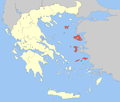 Regional unit of IkariaRegional unit of Lemnos
Regional unit of IkariaRegional unit of LemnosWorld Heritage Sites in Greece North Aigai · Mount Athos · Paleochristian and Byzantine Monuments of Thessalonica: (Hagios Demetrios, Arch and Tomb of Galerius, Hagia Sophia, Church of Panagia Chalkeon, Church of Saint Nicholas Orphanos, Church of the Holy Apostles, Church of the Acheiropoietos, Monastery of Latomos, Church of Saint Panteleimon)
Central Delphi · Epidaurus · Hosios Loukas · Meteora · Mycenae and Tiryns · Mystras · Old Town of Corfu · Olympia · Temple of Apollo Epicurius at Bassae
Attica Aegean Islands
and CreteThird Journey of Paul the Apostle Ionian League Categories:- Chios
- Ionian League
- Mediterranean port cities and towns in Greece
- Municipalities of the North Aegean
- Territories of the Republic of Genoa
Wikimedia Foundation. 2010.

